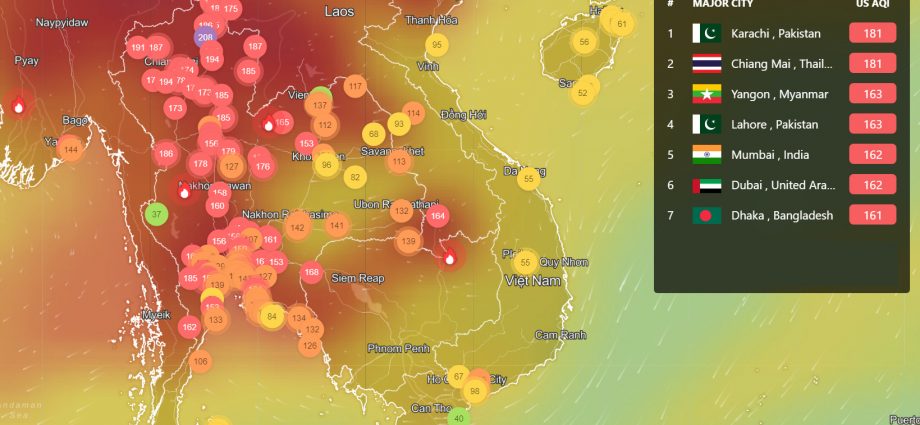
Toxic dust levels above the safe limit of 50 microgrammes per cubic metres (ug/m3) remained in the North, the Northeast, Bangkok and its surrounding provinces on Thursday.
Pinsak Surasawadi, director-general of the Pollution Control Department (PCD) in his capacity as chairman of the Centre for Air Pollution Mitigation, said the levels of particle matter 2.5 micrometres or less in diameter (PM2.5) levels have increased in all areas in 17 northern provinces on Thursday morning.
In northern Thailand, a total of 17 areas were classified in the orange zone, reflecting levels starting to affect health, and 15 areas in the red zone of serious health impacts.
PM 2.5 levels ranged between 91 and 136 ug/m3 in the provinces of Chiang Mai, Chiang Rai, Lamphun, Mae Hong Son, Nan, Tak, Sukhothai, Phitsanulok, Kamphaeng Phet and Uthai Thani, with the highest dust levels in tambon Thani of Sukhothai’s Muang district, said Mr Pinsak.
He blamed burning of agricultural waste and sugarcane plantations, coupled with weak winds and poor ventilation, for accumulated dust.
He urged locals to refrain from burning their agricultural waste before the dust situation eased. The smog is expected to cover the upper and lower North until March 14.
PM2.5 levels in many areas in the Northeast still exceeded safe levels. Eleven areas were in the orange zone, while four areas were in the red zone. In Loei, Nong Khai, Nakhon Phanom and Bueng Kan provinces, dust levels were reported at 94-124 ug/m3.
In Bangkok and its surrounding provinces, the air quality was at moderate to health risk levels. PM2.5 levels slightly fell in some areas.
Eighty-eight areas were in the orange zone while one area on Kanchanaphisek Road in Bang Khun Thian district was in the red zone, with PM dust level measuring at 109 ug/m3.
The dust situation in Greater Bangkok is expected to improve after March 11 as wind from the South will blow away dust, said the PCD chief.
However, people should take extra caution during March 14-16, as they will be affected by dust that cross the areas.
People are advised to keep abreast of the air quality via Air4Thai app, said the PCD chief.

Thailand air quality map – IQAir
In the northeastern province of Nakhon Phanom, PM2.5 dust levels were over the safe threshold in four districts on Thursday despite winds blowing away dust above the Mekong River.
Over the past two days, Muang, Ban Phaeng, Tha Uthen and That Phanom districts of Nakhon Phanom were blanketed in smog, with harmful levels of PM2.5 dust measured between 180 and 200 ug/m3.
Burning of agricultural waste along the border, coupled with the hot weather, caused toxic smog to cover the four districts. Although strong winds helped blow away dust in these areas in the morning, PM2.5 levels remained in an unsafe range between 80 and 100 ug/m3.
Authorities advised people to wear masks outdoors and avoid outdoor activities, as they would be at risk of respiratory diseases.

A firefighting robot LUF 60 has been sent to Phetchabun province to help reduce toxic dust levels. (Photo: Sunthorn Kongvarakhom)
In Phetchabun, ultrafine dust levels in many areas in this mountainous tourist province still exceeded the safety level.
According to the PCD’s Air4Thai.com, the PM2.5 level in Muang district of Phetchabun was measured at 88 ug/m3, as of 9am on Thursday.
On the same day, AirVisual app reported the PM2.5 dust level at 161 ug/m3 in Muang district, as of 8am.
Deputy Phetchabun governor Chatchawan Benjarisiwong said provincial authorities have sought for fire extinguisher robot LUF 60 devices from the Disaster Prevention and Mitigation to spray water to reduce dust in the province.
Three LUF 60 devices were expected to be sent to the province, said Mr Chatchawan.
Now, the department has sent one device to spray water to reduce dust in the province, particularly in economic and tourism zones in Muang, Lom Sak, Wichian Buri, and Khao Kho districts.

